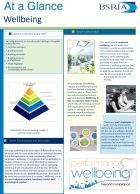BSRIA offers guidance on wellbeing

The topical subject of wellbeing in buildings is discussed in a free downloadable guide from BSRIA. These topic guides are designed to be ‘at-a-glance’ publications to introduce readers to key industry topics and suggesting further reading. The guide (TG10/2016 At a glance — wellbeing) details factors such as thermal comfort, noise and indoor air-quality.
Expert commentary is provided by BSRIA’s sustainable-building consultant Dr Michelle Agha-Hossein. She says, ‘Given that we spend 90% of our time indoors, it is important to know how the indoor environment can affect and improve our wellbeing. A building should be a safe place that responds to basic human needs while meeting the occupants’ psychological and spiritual needs.
‘A “well” indoor environment supports the occupants to thrive and happily perform to their optimum ability. As the industry is trying to optimise energy performance of buildings in terms of their installed services and fabric, it is essential to also consider how well buildings can increase the energy capacity of their occupants and help them to better control and spend the human energy that they have.
‘The aim of this guide is to provide a brief introduction about how a range of indoor physical, functional and psychological factors can impact the wellbeing of the occupants.’








